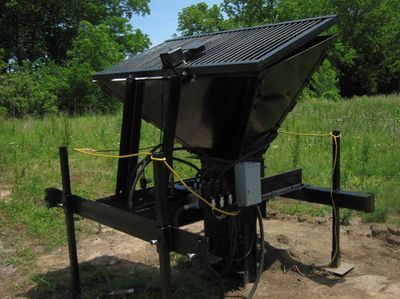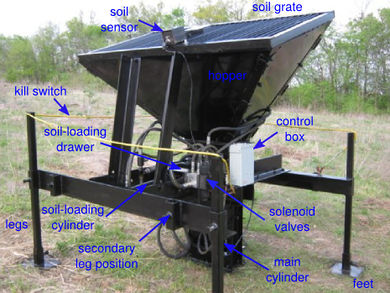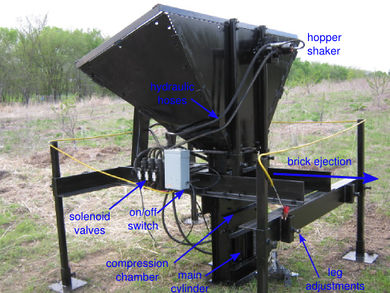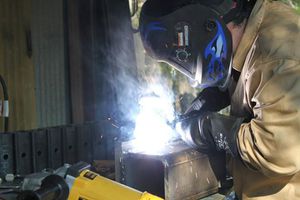CEB Press: Difference between revisions
(+warning) |
|||
| Line 13: | Line 13: | ||
<iframe src="http://sketchup.google.com/3dwarehouse/mini?mid=2f451a44a7518acdee8527d8341b9fd7&etyp=sw&width=400&height=300" frameborder="0" scrolling="no" marginheight="0" marginwidth="0" width="400" height="300"></iframe> | <iframe src="http://sketchup.google.com/3dwarehouse/mini?mid=2f451a44a7518acdee8527d8341b9fd7&etyp=sw&width=400&height=300" frameborder="0" scrolling="no" marginheight="0" marginwidth="0" width="400" height="300"></iframe> | ||
</html> | </html> | ||
{{Warning|The documentation for the CEB Press is undergoing a thorough overhaul. CAD models and written directions are presently obsolete. For more information, see [[Talk:CEB_Press#Documentation_overhaul_in_progress]]. When the models, specifications and text on this article have been thoroughly reviewed, updated when necessary, and confirmed as whole and accurate, this warning may be removed.}} | |||
==Detailed Description== | ==Detailed Description== | ||
Revision as of 01:30, 24 September 2011
| CEB Press | ||
|---|---|---|
| Home | Research & Development | Bill of Materials | Manufacturing Instructions | User's Manual | User Reviews | 
| |
Overview
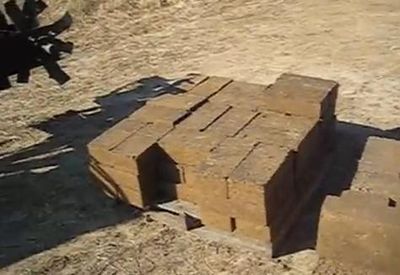
The "Liberator" Compressed Earth Block Press is a machine that makes compressed earth blocks (CEBs).
![]() Warning: The documentation for the CEB Press is undergoing a thorough overhaul. CAD models and written directions are presently obsolete. For more information, see Talk:CEB_Press#Documentation_overhaul_in_progress. When the models, specifications and text on this article have been thoroughly reviewed, updated when necessary, and confirmed as whole and accurate, this warning may be removed.
Warning: The documentation for the CEB Press is undergoing a thorough overhaul. CAD models and written directions are presently obsolete. For more information, see Talk:CEB_Press#Documentation_overhaul_in_progress. When the models, specifications and text on this article have been thoroughly reviewed, updated when necessary, and confirmed as whole and accurate, this warning may be removed.
Detailed Description
The CEB Press takes earth/dirt/soil and compresses it tightly to make solid blocks useful for building. Compressed earth blocks have many advantages as a building material: by making the building materials from the readily available dirt on the building site, they eliminate the need to transport bricks from elsewhere, reducing the financial cost and environmental impact of transport. Compressed earth blocks are very strong and insulate well against both heat and sound, making for very energy-efficient building (especially combined with the energy savings from not needing to transport them from offsite). Best of all, the material they use is already on-site and does not need to be purchased -- quite literally, dirt-cheap! See the wiki page on Compressed Earth Blocks and the CEB category for more details on building using CEBs.
The Liberator has been fully designed and tested by the Open Source Ecology team. Because the Liberator is an open source technology, you can freely download instructions to build your own from materials you can obtain yourself, or contact opensourceecology[at]gmail[dot]com to buy a kit or a finished machine.
Building a machine yourself might seem intimidating, but every step of the process is fully documented and the OSE community is available on our discussion forums if you need help, advice, or a little hand-holding.
Using the Liberator, two people can build a 6 foot high (1.83m) round wall, 20 feet (6.1m) in diameter, 1 foot (30cm) thick, in one 8 hour day, though construction time will vary somewhat depending on preparation time, what equipment is available (tractor to prepare the ground and move the blocks where they need to go), the quality of the soil, and other factors. The bigger the block size, the faster a wall can be erected, but at the cost of heavier blocks that are more of a strain to work with. Blocks from The Liberator average 25 pounds (11.3kg).
The torch table will be used to automate the fabrication of the CEB machine, reducing fabrication time by an estimated 20 hours and, thus, the cost to build the machine.
Components
The Liberator consists of -
- A Hopper at the top which you fill with loose dirt. This is made from welded steel. We made the hopper six feet wide, so it can hold a lot of dirt.
- Grate and grate shaker - the grate is at the bottom of the hopper. The grate shaker shakes it so that soil falls through into the compression chamber, while large stones and things like that are caught in the grate.
- A frame that bolts together for easy assembly and disassembly.
- A compression chamber where the bricks are actually pressed. This is a metal box with a nylon liner bolted on the inside. The liner gives the bricks a smoother finish. It will have to be replaced every hundred thousand bricks or so.
- Hydraulic cylinders - These are the muscles of the machine; they apply the pressure to the dirt. They are readily removable with pins. There are two hydraulic cylinders:
- The soil drawer - this moves from left to right and performs the dual function of loading soil into the compression chamber and ejecting blocks from the machine
- The main cylinder, which moves up and down and compresses the blocks
- Tractor mount, where an external hydraulic power source can be attached to the hydraulic cylinders.
- Pressure gauge, which monitors the amount of pressure used by the hydraulic system to ensure a certain density of brick.
- Controller Box controls the timing and sequence of operations.
Product Ecology
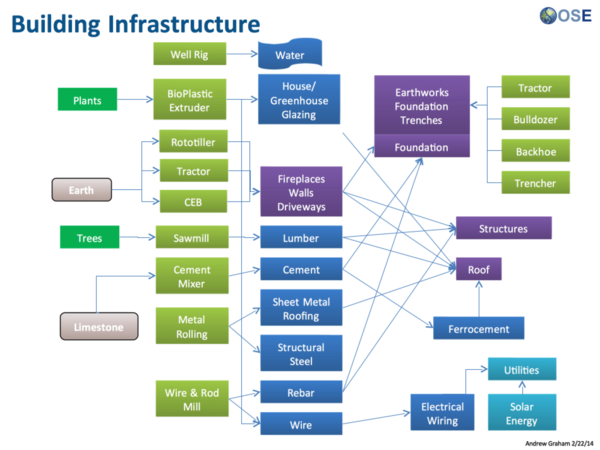
See Product Ecologies for more information.
Uses
 Induction Furnace Steel
Induction Furnace Steel Welder pieces
Welder pieces CNC Torch Table plates and holes
CNC Torch Table plates and holes Ironworker holes
Ironworker holes Power Cube for power
Power Cube for power
Creates
- CEB Bricks for Workshop, Greenhouse, HabLab, etc
Solution Statement
The CEB Press provides a solution for using soil as a viable building construction material.
Specifications
| Bricks per minute output | 16 |
|---|---|
| Brick size | 12x6x6 inches (30.5x15.3x10.2 cm) |
| People operating machine | 1-2 |
| Power source | Tractor hydraulics or any hydraulic power source with 6 gallon per minute capacity (22.71 liters per minute) |
| Machine mounting | tractor 3 point hitch or stand-alone foot |
| Hydraulic pressure | 2000psi / 137.90 bar |
| Hydraulic cylinder | 5 inch diameter, 19.6 inch area; 2.5 inch rod |
| Pressing cylinder pressure | 39,250 lb pushing force (~18 tons) |
| Controls | 2 spool, manual, hydraulic valve; automatic version forthcoming. |
| Compressive strength of bricks | 795psi (54.81 bar) using plain earth. 1200psi (82.74 bar) with 10% Portland cement. Strong enough to build a 60-story building [1] |
| Materials: | Structural cold rolled steel construction throughout |
| Height: | 6 foot 11 inches/ 210.82 cm |
| Machine lifetime goals: | 1 million bricks before repairs; liner may be replaced every 100,000 bricks |
| Fabrication time requirement for optimized production: | 3-5 days, about 20 hours of direct fabrication |
| Manual fabrication tooling requirements: | drill press, welder, acetylene torch |
| Optimal fabrication tooling: | XYZ table with torch, MIG welder, hoist |
| Material costs: | $1000-1350 |
Status
Currently the CEB is at product release status and is being actively manufactured at Factor e Farm. The presses will be used heavily as a part of the Factor e Farm Infrastructure Buildout 2011.
See: Brianna Log for production run status updates
The CEB documentation is being actively upgraded to meet Fabrication_Procedure_Standards with the goal of serving as a reference implementation for GVCS documentation.
The first independent replication is in process as of Sep. 2, 2011, by James Slade and Jason Smith in Texas.
See Also
